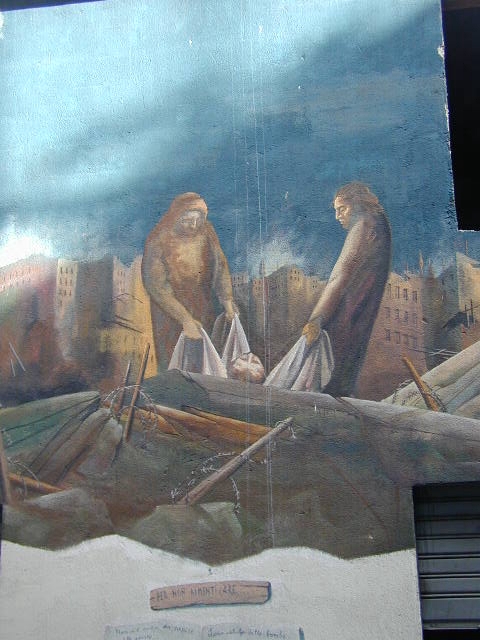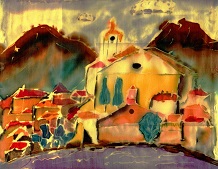zurück

Murales Wandgemälde in Orgosolo Sardinien Wallpictures Orgosolo
Sardinia muertestreeart graffti
Here are some key aspects of
street art:
1.
Forms and Techniques of Street Art:
-
Graffiti: One of the most well-known forms of street art, typically
involving writing or spraying
designs on walls using spray paint. Graffiti often includes stylized
lettering, tag names, and bold colors.
-
Stickers: Sticker art
is a form of street art where artists design and then stick their creations
on surfaces in public spaces.
-
Posters: Street artists often use
posters to display their
work. These can be large-scale pieces or smaller, more intricate designs.
-
Mosaics: Some street
artists use tiles or
other materials to create intricate
mosaic art that is then
installed on public surfaces.
-
Stencil Art: This
technique involves creating an image or design on a stencil, which is then
applied to surfaces using spray paint or other materials. The stencil allows
for a repeated and detailed image.
-
Street Installations:
Artists sometimes create
three-dimensional or interactive art pieces that are placed in
public spaces. These can include sculptures, rearranged objects, or
installations made from unconventional materials.
-
Yarn bombing: A form of
guerilla knitting, where
artists cover objects like trees, fences, or statues with knitted or
crocheted fabric, creating colorful public displays.
2.
Famous Street Artists:
-
Banksy: Arguably the most
famous contemporary street artist, Banksy’s politically charged art often
tackles issues like war, capitalism, and social inequality. His work, which
often includes satire and dark humor, is characterized by
stenciled images and
social commentary.
-
Jean-Michel Basquiat:
Initially known for his graffiti in New York City, Basquiat went on to
become a renowned painter. His work often incorporated
abstract imagery,
text, and
symbols that conveyed his
thoughts on race, identity, and society.
-
Keith Haring: Known for
his bold, colorful designs and social activism, Haring’s street art is often
filled with animated figures,
radiating lines, and
symbols. His work touched
on themes of love,
death,
war, and
political issues.
-
Shepard Fairey: Famous
for the Obey Giant
campaign and his iconic Hope
poster of Barack Obama, Fairey combines street art with
graphic design and
propaganda aesthetics to
create politically charged works.
-
RETNA: Known for his
unique calligraphy style, RETNA incorporates
lettering from a variety
of cultures into his street art. His work merges
typography with
expressive linework.
3.
Themes and Messages in Street Art:
-
Social Commentary: Many
street artists create works that reflect social issues, such as
poverty,
inequality,
racism,
climate change, and
political activism. These
works often aim to provoke thought or inspire action in the public.
-
Rebellion: Street art has
often been seen as a form of resistance against
authorities,
corporate power, and
mainstream culture. It
challenges the status quo and is frequently used as a form of protest.
-
Identity and Self-Expression:
For many artists, street art is a way to assert their personal identity,
express emotions, and communicate with others in an often
anonymous way.
-
Urban Decay and Renewal:
Street art can be a way of reclaiming public spaces, revitalizing
run-down neighborhoods,
or transforming blighted
areas into spaces of creative expression.
-
Pop Culture: Many street
artists incorporate elements of
pop culture, using imagery from
advertising,
comics,
cartoons, and
celebrity culture to make
commentary on modern life.
4.
Street Art vs. Graffiti:
While often used interchangeably,
street art and
graffiti are distinct in some
ways:
-
Graffiti typically refers
to writing, particularly tags
or letters, and is seen
by some as a form of vandalism.
It tends to be more about the artist's name or identity.
-
Street art is generally
more visually focused,
often involving detailed images, stencils, or murals, and can be more
socially or politically charged. Some forms of street art, like murals, are
commissioned and welcomed by local authorities, while others remain
illegal and subversive.
5.
Street Art’s Legality:
Street art can be a
contested space legally.
While some street art is commissioned and supported by local governments or
private businesses, much of it is created
illegally, without the
permission of property owners. This often leads to legal challenges, including
fines and arrest, but also fuels the
countercultural nature of street art.
-
Public vs. Private Spaces:
Many street artists choose to work on
abandoned buildings,
walls, or
highways, where their
work may remain unnoticed or unpoliced.
-
Art Galleries: As street
art has grown in popularity, it has increasingly found its way into art
galleries and museums. Some street artists, like
Banksy, have even created
exhibitions to highlight
their works, bridging the gap between street art and the mainstream art
world.
6.
Famous Street Art Locations:
-
Berlin: The
Berlin Wall has become an
iconic canvas for street art, with colorful murals and graffiti covering the
remnants of the wall, serving as a powerful symbol of
freedom and
unity.
-
New York City: New York
City, particularly neighborhoods like
Williamsburg and
Bushwick in Brooklyn, is
home to some of the most significant street art scenes, with murals,
stencils, and graffiti adorning building facades.
-
London:
Shoreditch and
East London are known for
their vibrant street art, with works from famous artists like
Banksy and others.
-
Melbourne: Melbourne is
often considered one of the street
art capitals of the world, with areas like
Hosier Lane showcasing
ever-evolving street murals and works by both local and international
artists.
-
Los Angeles:
Los Angeles is home to
the LA graffiti culture
and has produced numerous influential street artists who have gone on to
become icons in the art world.
7.
Street Art as a Global Movement:
Street art has grown into a global cultural
phenomenon. Artists from all
over the world contribute to the ever-changing urban landscapes. Festivals like
The Street Art Festival in
Miami and
Upfest in
Bristol, UK, showcase new
street art and bring together artists from across the globe.
-
Art for Social Change:
Street art is increasingly used as a tool for
social change, allowing
marginalized voices to express themselves and raise awareness about social
justice issues.
Conclusion:
Street art is an exciting and dynamic form of
visual expression that pushes
the boundaries of art by creating pieces in
public spaces. It has evolved
from underground subcultures
to a mainstream art movement, influencing both
artistic communities and
society at large. Whether
political, playful, or deeply personal, street art connects artists to the world
around them and encourages a dialogue
between the artist and the viewer.
 26.07.25 Copyright Dirk
Rauschenbach Koelnerstrasse 293 51702 Bergneustadt
Datenschutzerklaerung 02261 9788972 Mail ccooly(
at) web.de
26.07.25 Copyright Dirk
Rauschenbach Koelnerstrasse 293 51702 Bergneustadt
Datenschutzerklaerung 02261 9788972 Mail ccooly(
at) web.de
 Safaris
Bergsteigen
Wandern
Inselwandern Weltweit
Safaris
Bergsteigen
Wandern
Inselwandern Weltweit
 Europa
Inselwandern
Europa
Inselwandern
 Städtewandern
Städtewandern
 Paintings
Paintings Dirk Rauschenbach
Dirk Rauschenbach
 Safaris
Bergsteigen
Wandern
Inselwandern Weltweit
Safaris
Bergsteigen
Wandern
Inselwandern Weltweit
 Europa
Inselwandern
Europa
Inselwandern
 Städtewandern
Städtewandern
 Paintings
Paintings Dirk Rauschenbach
Dirk Rauschenbach

![]() 26.07.25 Copyright Dirk
Rauschenbach Koelnerstrasse 293 51702 Bergneustadt
Datenschutzerklaerung 02261 9788972 Mail ccooly(
at) web.de
26.07.25 Copyright Dirk
Rauschenbach Koelnerstrasse 293 51702 Bergneustadt
Datenschutzerklaerung 02261 9788972 Mail ccooly(
at) web.de